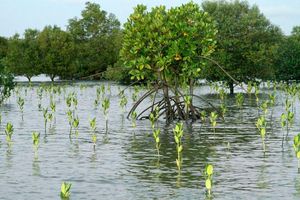Mangrove committees boost community carbon trading

Mangroves. The mangrove wetland has steadily been hived off for rice farming. PHOTO | FILE | NMG
What you need to know:
Through the formation of County Mangrove Committees (CMCs), the government and communities will now work together with the county governments of Kwale, Mombasa, Kilifi, Lamu and Tana River to protect 61,000 hectares of mangroves
With an increase in the number of people interested in doing carbon trading business, the committees come as a huge boost to residents who want to earn carbon credits
A carbon credit is a kind of permit that represents one tonne of carbon dioxide removed from the atmosphere and costs Sh600
Conservation of mangroves at the Kenyan coast has received a major boost after the government stepped up efforts to create a new structure for the protection of high carbon ecosystems.
Through the formation of County Mangrove Committees (CMCs), different stakeholders from the government and communities will now work together with the county governments of Kwale, Mombasa, Kilifi, Lamu and Tana River to protect the 61,000 hectares of mangroves along the country’s coastline.
Deputy Chief Conservator of Forests at the Kenya Forest Service (KFS) Charity Munyasia said that the formation of the committees was critical to environmental conservation.
“We are forming these committees to monitor the activities that are happening within our mangrove ecosystems,” she said.
The mangroves at the coastal regions have long been endangered with communities cutting them down for charcoal and construction.
But with an increase in the number of people interested in doing carbon trading business, the committees come as a huge boost to residents who want to earn carbon credits.
A carbon credit is a kind of permit that represents one tonne of carbon dioxide removed from the atmosphere and costs Sh600.
The trade involves companies or individuals abroad who are offsetting carbon in the atmosphere investing in projects such as the growth of the mangroves which absorb a considerable amount of carbon dioxide.
For instance, some communities are already doing carbon trading in Vanga and Gogoni-Gazi areas in Kwale County. The government and local organizations are also targeting to extend the trade to Lamu which hosts the highest percentage of mangrove forests in Kenya.
The project in Vanga looks to protect its forests by funding mangrove conservation through the sale of carbon credits on the voluntary carbon market, verified by the Plan Vivo carbon trading standard.
“Globally, this is one of the first projects that is trading carbon credits from mangrove conservation and restoration,” said UN Environment mangroves expert Gabriel Grimsditch.
Ms Munyasia said the committees will also ensure that research done by various state agencies is used for the conservation of mangroves.
“We have come up with terms of reference for county mangrove committees, each county will have a CMC where all the stakeholders and partners will be participating so that they plan together and jointly conserve the mangroves,” she said
Each committee will have a maximum of nine members, and any other person who is involved in the blue economy come will be allowed to participate.
“The mangroves are very important in halting climate change, they absorb 10 times more carbon than trees on the land,” Ms Munyasia said adding that they also protect communities from being submerged by water.




